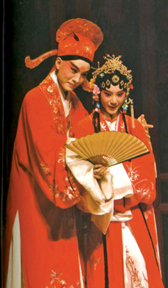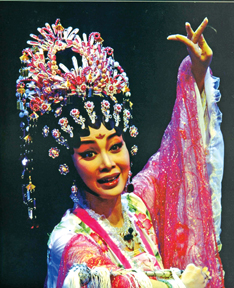 |
|
Mei Lanfang as Lady Yang in ‘The
Drunken Beauty’ Pictures: ‘Arts in China’ by Jin Yong |
Opting for opera
Exploring the rich canvas of Chinese opera throughout
the decades :
Ruwini JAYAWARDANA in Beijing
For centuries the glorious art forms of Greek tragicomedy, Indian
Sanskrit plays and Chinese opera have traversed many a decade hand in
hand, delighting many an audience with their explicit beauty, unparallel
touch with the country's customs and traditions and rich costumes.
Unfortunately with the years rolling by these rich sources of art have
faded into the background to be buried in history but luckily one form
of art still lies preserved, handed down from generation to generation.
Rooting from the third century CE, Chinese opera had taken a long
stride to make it to the modern world. Though an extremely stylized art
form, it still holds the power to capture audiences from all parts of
the globe and has its own unique identity embellished in the folds of
the society today. Chinese opera is synonymous for its stylized dance
forms and music accompanied with illuminating costumes; make up,
jesters, acrobatic gestures, poetry and marital art.
All these features come together to present the traditional art form
of the country in a more refined and attractive manner so that it had
survived for centuries and has come to a place where it is regarded as
one of China's main showpieces in staging its magnificent cultural
heredity to the world.
 |
|
Chuanju
opera |
The earliest evidence linked to Chinese opera emerged in the Song
Dynasty (A.D. 960 to 1279). Later during the era of the first emperor
Kublai Khan in the Yuan Dynasty' (A.D. 1279 to 1368) opera became so
popular that the Golden age of the Classical Opera. More then 300 types
of Chinese operas are staged both in the grand stages of the main cities
as well as the rural areas in China today.
However there are thirty odd forms of opera which are used as the
main form of entertainment for the locals as well as international
audience. Shanxi Opera, Beijing Opera, Shanghai Opera and Cantonese
Opera are examples of some of the most popular forms of Chinese opera
which have emerged with the years. Many of the plots of this form of art
are constructed in such as manner that it inspired the viewers to
reflect on the great changes in China's history. Singing, reciting,
posing and skill for fighting are essential for actors to excel in the
field. The characters communicate with each other and narrate the tale
to the audience through verses sung by the actors and accompanied with
graceful movements and facial expressions.
Reciting the dialogues or monologues too takes on a musical note and
the rhythm differs according to the situation and characters that an
actor portrays.
Fighting comprises dance movements or an artistic adaptation of the
country's traditional martial arts as dual scenes or episodes depicting
war are frequently adapted into the tales. Time and space of the Chinese
stage are linked with the imagination. Therefore after a particular
character leaves the stage, his or her entrance the next moment can
signify a different time and place.
Similarly symbolism too has an important to play in Chinese opera. A
dame lighting a lamp suggests nightfall and if she blows out the lamp
after singing a song it suggests dawning of the day. Similarly an actor
holding a long baton decorated with bright stresses to depict a
horsewhip symbolizes a fine horse.
The characters in Chinese opera fall into four main categories: Sheng,
Dan, Jing and Chou. Out of these Sheng suggests handsome male roles
which can be subdivided according to their age and status.
Similarly the female roles titled Dan too fall under several
subdivisions according to their age and status. Jing is the male role
which has the actor wearing paint on his face while Chou is the comic or
ugly roles played by males and females.
 |
 |
 |
 |
|
The Peach Blossom Fan |
The Peony
Pavilion |
A scene
from an opera staged in Guangdong, China, recently |
A scene
from the King Xiang Yu’s Farewell to
his Beloved (Farewell My Concubine) |
The Chinese are famous for their glamorous costumes of vibrant
shades. Undoubtedly this fact also comes into play when considering
their opera costumes. Rich embroidery, magnificent headdresses, jeweled
accessories and clothing and high court boots are attractive features
that capture many an interest.
The high pitched sound of strings and woodwinds, the screeching
falsetto of the singers or the noisy clanging of gongs and drums may
seem strange to those who are used to the Western opera but these are
also essential features of the Chinese opera.
It is such unique features coupled with true talent displayed by the
actors which has kept this ancient form of art alive and thriving among
the audience. |



